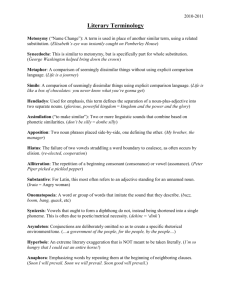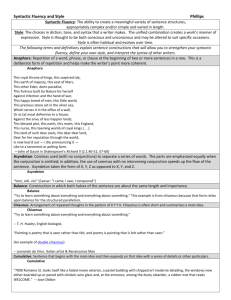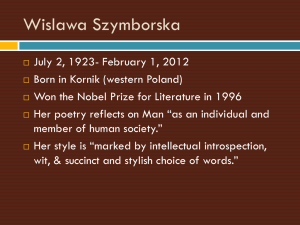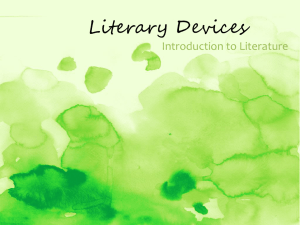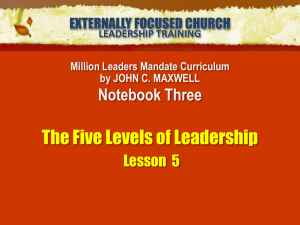Chiasmus: An Important Structural Device
advertisement
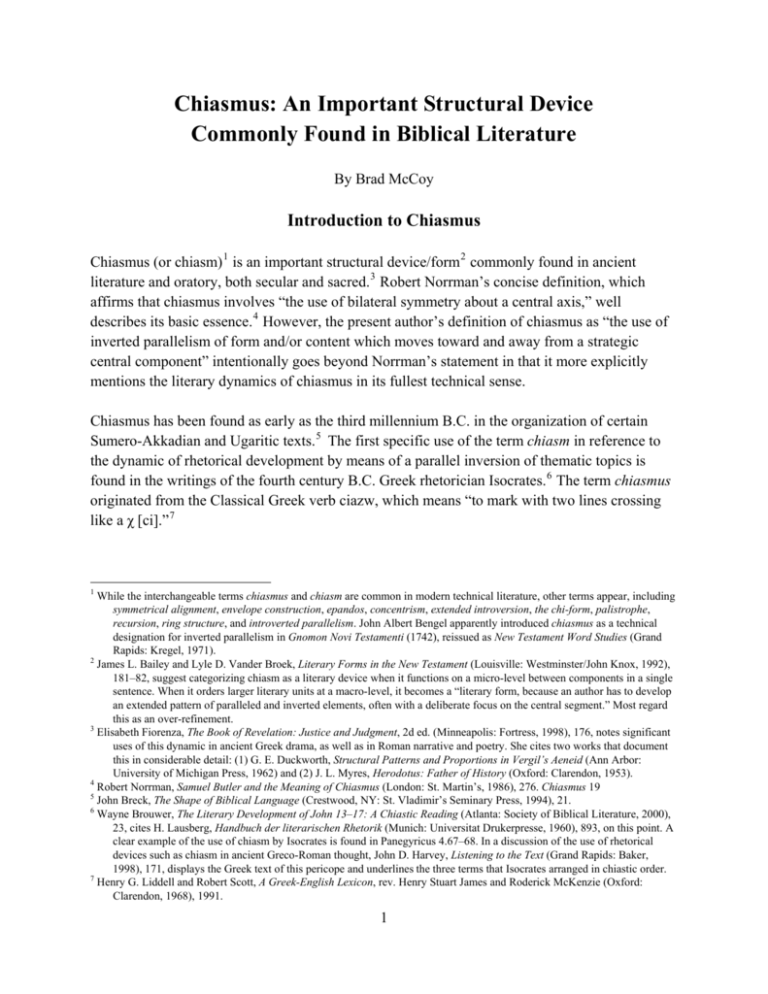
Chiasmus: An Important Structural Device Commonly Found in Biblical Literature By Brad McCoy Introduction to Chiasmus Chiasmus (or chiasm) 1 is an important structural device/form 2 commonly found in ancient literature and oratory, both secular and sacred. 3 Robert Norrman’s concise definition, which affirms that chiasmus involves “the use of bilateral symmetry about a central axis,” well describes its basic essence. 4 However, the present author’s definition of chiasmus as “the use of inverted parallelism of form and/or content which moves toward and away from a strategic central component” intentionally goes beyond Norrman’s statement in that it more explicitly mentions the literary dynamics of chiasmus in its fullest technical sense. Chiasmus has been found as early as the third millennium B.C. in the organization of certain Sumero-Akkadian and Ugaritic texts. 5 The first specific use of the term chiasm in reference to the dynamic of rhetorical development by means of a parallel inversion of thematic topics is found in the writings of the fourth century B.C. Greek rhetorician Isocrates. 6 The term chiasmus originated from the Classical Greek verb ciazw, which means “to mark with two lines crossing like a χ [ci].” 7 1 While the interchangeable terms chiasmus and chiasm are common in modern technical literature, other terms appear, including symmetrical alignment, envelope construction, epandos, concentrism, extended introversion, the chi-form, palistrophe, recursion, ring structure, and introverted parallelism. John Albert Bengel apparently introduced chiasmus as a technical designation for inverted parallelism in Gnomon Novi Testamenti (1742), reissued as New Testament Word Studies (Grand Rapids: Kregel, 1971). 2 James L. Bailey and Lyle D. Vander Broek, Literary Forms in the New Testament (Louisville: Westminster/John Knox, 1992), 181–82, suggest categorizing chiasm as a literary device when it functions on a micro-level between components in a single sentence. When it orders larger literary units at a macro-level, it becomes a “literary form, because an author has to develop an extended pattern of paralleled and inverted elements, often with a deliberate focus on the central segment.” Most regard this as an over-refinement. 3 Elisabeth Fiorenza, The Book of Revelation: Justice and Judgment, 2d ed. (Minneapolis: Fortress, 1998), 176, notes significant uses of this dynamic in ancient Greek drama, as well as in Roman narrative and poetry. She cites two works that document this in considerable detail: (1) G. E. Duckworth, Structural Patterns and Proportions in Vergil’s Aeneid (Ann Arbor: University of Michigan Press, 1962) and (2) J. L. Myres, Herodotus: Father of History (Oxford: Clarendon, 1953). 4 Robert Norrman, Samuel Butler and the Meaning of Chiasmus (London: St. Martin’s, 1986), 276. Chiasmus 19 5 John Breck, The Shape of Biblical Language (Crestwood, NY: St. Vladimir’s Seminary Press, 1994), 21. 6 Wayne Brouwer, The Literary Development of John 13–17: A Chiastic Reading (Atlanta: Society of Biblical Literature, 2000), 23, cites H. Lausberg, Handbuch der literarischen Rhetorik (Munich: Universitat Drukerpresse, 1960), 893, on this point. A clear example of the use of chiasm by Isocrates is found in Panegyricus 4.67–68. In a discussion of the use of rhetorical devices such as chiasm in ancient Greco-Roman thought, John D. Harvey, Listening to the Text (Grand Rapids: Baker, 1998), 171, displays the Greek text of this pericope and underlines the three terms that Isocrates arranged in chiastic order. 7 Henry G. Liddell and Robert Scott, A Greek-English Lexicon, rev. Henry Stuart James and Roderick McKenzie (Oxford: Clarendon, 1968), 1991. 1 In its most general sense, chiasmus involves inverted parallelism between two or more (synonymously or antithetically) corresponding words, phrases, or units of thought. Examples of this basic dynamic would include the contemporary saying, “Winners [A] never quit [B] and quitters [B’] never win [A’],” as well as the biblical description of Christ in Revelation 3:7: He who opens [A] and no one shuts [B], and shuts [B’] and no one opens [A’]. This type of inverted parallelism between corresponding components can take place at a micro level (within a single sentence) or at a macro level (within the broad flow of a large discourse). While chiasm inherently involves inverted parallelism, it takes this parallelism, in a sense, one step further. 8 Although some would apply the term chiasmus to an ABB’A’ structure of only two parallel components, technically this kind of literary organization is more correctly categorized as inverted parallelism. 9 In the sense that the term is used in modern technical literature, chiasmus always involves a balanced multi-unit inverted parallelism which leads to and then moves away from a distinct central component (which itself can be either in the form of a single unit [as in ABCB’A’] or in the form of two parallel subunits [as in ABCC’B’A’]). 10 A restatement of the example used above—“Winners [A] never quit [B], and therefore, perseverance is an important key to success, [C] because quitters [B’] never win [A’]”— illustrates chiasmus in this full technical sense. Worded in this way, the statement clearly revolves around the axis of the central component [C]. The chiasm, thus, explicitly states what the previous example of inverted parallelism only implied. This is accomplished by means of the corresponding components of the inverted parallelism of the chiasm (A/A’ and B/B’) building to and then moving away from the central affirmation, “perseverance is an important key to success,” as the emphatically placed, pivotal [C] proposition of the chiasm. In an attempt to emphasize properly the importance of a central component in chiasmus, one team of scholars 11 has recommended that displays of chiastic structures designate the pivotal central component with an “X” (as in ABXB’A’ or ABXX’B’A’). This helpful suggestion facilitates an active recognition of the fact that the “uniqueness of chiasmus, as distinct from 8 Mary H. Schertz and Perry B. Yoder, Seeing the Text: Exegesis for Students of Greek and Hebrew (Nashville: Abingdon, 2001), 52. 9 Bailey and Vander Broek, Literary Forms in the New Testament, 49. 20 CTS Journal 9 (Fall 2003) 10 This view slightly extends that of Mitchell Dahood, “Chiasmus,” in The Interpreter’s Dictionary of the Bible, ed. K. Crim et al., Supplementary Volume (Nashville: Abingdon, 1976), 45, who subdivides chiastic structures into two types based on their number of components. He uses micro-chiasm for structures which consist of four members, that is, two sets of parallel components with or without a distinct central climactic component. Macro-chiasm refers to structures made up of six or more members, that is, a minimum of three sets of parallel components. The present author uses these three distinct terms in three specific ways: (1) simple chiasm or simple chiasmus for ABB’A’ structures of two parallel components, (2) chiasm or chiasmus for ABCB’A’ or ABCCB’A’ the classic structure composed of two parallel components framing a central (either singular or paired) component, and (3) macro-chiasm or macro-chiasmus for ABCDC’B’A’ or ABCDD’C’B’A’ structures made up of three or more paired components. The Prologue and the Epilogue of Revelation illustrate ABCDC’B’A’ macrochiasms. In addition to these specific designations, this writer will at times use the adverb chiastically and the adjective chiastic nontechnically to describe in general terms the dynamics of inverted parallelism that characterize simple chiasms, chiasms, and macro-chiasms. 11 Schertz and Yoder, Seeing the Text, 54. Chiasmus 21 2 other forms of parallelism, lies in its focus upon a pivotal theme, about which the other propositions of the literary unit are developed.”12 In view of this emphasis inherent in chiastic structures, be they literary or oral, Welch suggests that conceptually chiasms should be conceived of as a series of concentric circles, as opposed to simply a series of parallel lines. 13 Two other illustrations may help elucidate the semantic impact of chiastic structuring. The first is a vertical stairway of thought initially ascending to and then descending from a central, climactic pivot point. The second is a horizontally oriented rhetorical pointer that focuses the attention of the overall discourse on that central thought unit. An excellent example of a classic chiasm, made up of two parallel components (A/A’ and B/B’) that build to and then move away from a central component (X), is found in 1 John 3:9: A whoever has been born of God B does not sin X for His seed remains in him B’ and he cannot sin A’ because he has been born of God The Use of Chiasmus in Ancient Literature Generally Toward the end of his epic work Histories, Herodotus describes the amazement of Xerxes at reports of Artemisia’s heroic actions in connection with the Battle of Salamis. Responding to this unexpected good news in the midst of a larger disaster, Xerxes chiastically (in a non-technical sense) exclaimed, “My men have behaved like women, and my women like men!” 14 The common usage of chiasmus in much of the literature of antiquity (at both a micro and a macro level) has often been overlooked by contemporary interpreters. 15 This is due in part to the fact that “the modern mind is not rehearsed in the use, appreciation, or even the recognition of 12 Breck, The Shape of Biblical Language, 18. Even more ingenious is a suggestion by Michael Payne, “Voice, Metaphor and Narrative,” in Mappings of the Biblical Terrain: The Bible as Text, ed. Vincent L. Tollers and John Maier (Lewisburg, PA: Bucknell University Press, 1990), 369. He sees the chiastic structure of the book of Revelation as “concentric or intercalated,” such that the “architectonics of the text resemble the structure of the menorah, linking the first branch with the seventh, the second with the sixth, the third with the fifth, leaving a central unpaired fourth branch.” 22 CTS Journal 9 (Fall 2003) 14 Herodotus Histories 8.88.3. 15 Bailey and Vander Broek, Literary Forms in the New Testament, 182. 13 3 chiasmus.” 16 Charles Lock emphasizes that, in contrast to the writing patterns of ancient times, which commonly involved a chiastic structuring of thought, textual development “as linear, progressive and logical is a sophisticated refinement that characterizes modernity.” 17 An important contributing factor to this dynamic (specifically relative to modern English speakers and writers) is that “an inflected language such as Hebrew or Greek has greater flexibility than English, making it easier to invert the order of semantic, grammatical, and syntactical components.” 18 However, the work of scholars beginning as early as the third decade of the 19th century (with the introductory work of Jebb and Boys 19 and more recently with the contributions of the groundbreaking work of Lund, 20 followed by scholars such as Breck, 21 Stock, 22 and Welch 23 ) has documented chiasm as an important rhetorical device/form often employed in both the writings and the orations of the ancient world. The use of chiasmus in antiquity was encouraged by the fact that it provided “a needed element of internal organization in ancient writings, which did not make use of paragraphs, punctuation, capitalization and other synthetic devices to communicate the conclusion of one idea and the commencement of the next.” 24 A second major factor which reinforced the use of chiastic organization of rhetorical material in the ancient mind is its inherent benefit as a mnemonic aid. “Relatively unconcerned about a linear . . . flow of ideas, biblical communities relished sayings . . . that were memorable, and they appreciated repetition that we might consider redundant.” 25 Without ready access to inexpensive pen and paper to make notes, they used chiasmus for memorization. Breck notes, “The ancients learned by rote. . . . Once [an individual] had in mind the first half of . . . a chiastic structure, it was a relatively easy matter to recall the rest.” 26 16 John W. Welch, “Introduction,” in Chiasmus in Antiquity: Structure, Analysis, Exegesis, ed. John W. Welch (Hildesheim, Germany, 1981; reprint, Provo, UT: Research Press, 1998), 13. It is also true that while it is often unnoted, modern vernacular English does commonly use the dynamics of chiasm (Mardy Grothe, Never Let a Fool Kiss You and Never Let a Kiss Fool You: Chiasmus and a World of Quotations That Say What They Mean and Mean What They Say (New York: Viking, 1999). 17 Charles Lock, “Some Words After Chiasmus,” in John Breck, The Shape of Biblical Language (Crestwood, NY: St. Vladimir’s Seminary Press, 1994), 362–63. 18 Schertz and Yoder, Seeing the Text, 52. 19 John Jebb, Sacred Literature (London: Cadell and Davies, 1820); and Thomas Boys, Tactica Sacra (London: Hamilton, 1824) and Key to the Book of Psalms (London: Seeley, 1825). Chiasmus 23 20 Nils W. Lund, Chiasmus in the New Testament: A Study in the Form and Function of Chiastic Structures (Chapel Hill: University of North Carolina Press, 1942; reprint, Peabody, MA: Hendrickson, 1992). 21 John Breck, “Biblical Chiasmus: Exploring Structure for Meaning,” BTB 17 (April 1987): 70–74; and The Shape of Biblical Language. 22 Augustine Stock, “Chiastic Awareness and Education in Antiquity,” BTB 14 (January 1984): 23–27. 23 Chiasmus in Antiquity: Structure, Analysis, Exegesis, ed. John W. Welch, contains pertinent essays by John W. Welch, Yehuda T. Radday, Wilfred G. E. Watson, Bezalel Porten, and Jonah Fraenkel. See especially John W. Welch, “Chiasmus in Ugaritic,” 36–49, in this book. 24 Stock, “Chiastic Awareness,” 23. 25 Bailey and Vander Broek, Literary Forms in the New Testament, 182. 26 Breck, The Shape of Biblical Language, 60. 4 A third major factor is the reality that ancient Greek thinkers “were trained throughout their school years to read from the center outward and from the extremities towards the center.” 27 Beginning students of the Greek alphabet were trained to conceive of its twenty-four letters in three distinctively different ways. First, the alphabet was taught from beginning to end (from alpha to omega). After this it was also taught “backwards, from omega to alpha, and then both ways at once, alpha-omega, beta-psi . . . (to) mu-nu (in the middle). 28 All of these factors are consistent with an inherent characteristic of the common medium of scrolls in the ancient world (it was probably not until the early second century A.D. that “the codex, or leaf-form of book began to come into extensive use in the Church”). 29 When fully unrolled, a scroll creates a symmetrical perception of the overall content and leads to a focus on the content in its center. Such information concerning the most basic paradigms of ancient thought and education makes it clear that the chiastic structure as an organizing principle in communication would have been readily grasped by thinkers in the ancient Greco-Roman world 30 and those cultures directly impacted by it, which after the time of Alexander the Great included not only the entire Mediterranean basin, but areas as far east as the Kyber Pass. Talbert has in fact demonstrated that, even prior to this, chiasmus was commonly utilized in the literature of ancient Semitic civilizations. 31 In the preface to a volume of essays on the use of chiastic structures in oral and written discourses in the ancient world entitled Chiasmus in Antiquity, David Noel Freedman states, “Chiasm occurs to one degree or another in most languages and literatures.” 32 Craig Blomberg notes that the essays making up the body of this book demonstrate “the widespread use of chiasmus in both prose and poetry . . . throughout the ancient Near East.” 33 This includes documentation of the use of chiasmus as a common structural literary convention in such wideranging settings as Sumero-Akkadian literature, Ugaritic writings, Aramaic contracts and letters, Talmudic-Aggadic narratives, and many classic works of ancient Greek and Latin literature. 27 Ibid., 29. 24 CTS Journal 9 (Fall 2003) H. I. Marrou, A History of Education in Antiquity (New York: Sheed and Ward, 1956), 151. 29 Bruce M. Metzger, The Text of the New Testament, 3d ed. (Oxford: University Press, 1992), 6. Exactly when scribes switched from the scroll to the codex is debated, however. In describing the historical background of the title for the book, David E. Aune, The New Testament in Its Literary Environment, Library of Early Christianity, ed. Wayne A. Meeks, vol. 8, 226, suggests: “When the Apocalypse was copied on papyrus [sc]rolls, early in its textual history, a simplified form of this initial sentence, ‘Apocalypse of John’ (using the shortest possible title and the author’s name in the genitive) . . . was used as a title, or subscription at the end . . . [later, when] the Apocalypse was copied in page form, the title was moved to the beginning” (italics his). 30 Stock, “Chiastic Awareness,” 23–27, notes that Cicero arranged portions of his play Atticus chiastically and claimed this had been inspired by similar usages of chiasmus by Homer. 31 Charles H. Talbert, Literary Patterns, Theological Themes, and the Genre of Luke-Acts (Missoula: Scholars, 1974), 67–70. Chiasmus 25 32 David Noel Freedman, “Preface,” in John Breck, The Shape of Biblical Language (Crestwood, NY: St. Vladimir’s Seminary Press, 1994), 7. 33 Craig Blomberg, “The Structure of 2 Corinthians 1–7,” CTR 4 (Fall 1989): 5. 28 5 The Use of Chiasmus in Biblical Literature Specifically As a general axiom, one scholar has noted, “On [both] micro and macro levels chiasmus has been shown to be a basic element in the formal structure of biblical literature.” 34 The seminal modern work which has proven to be foundational to the contemporary recognition of the importance of chiasmus as a literary device/form in biblical literature is Chiasmus in the New Testament by Nils Lund, first published in 1942. 35 This volume was “the first major, systematic treatment of the subject.”36 Scholars since Lund who have especially emphasized the importance of chiasmus and incorporated this appreciation into their analyses of major biblical texts include Blomberg, 37 di Marco, 38 Fiorenza, 39 Gaechter, 40 and Luter. 41 The use of chiasm as a major structural feature in the Bible is rooted in the fact that chiasm “infused the thought and speech patterns of the Semitic mind, and in this manner found its way into the Old Testament and then into the New Testament.” 42 In an important work on biblical interpretation entitled The Hermeneutical Spiral, Osborne affirms the strategic importance of chiasmus in biblical literature: “[A] technique that highlights major themes [in the Old Testament writings] is chiasm, which reverses words or events in successive parallel clauses or sections.” 43 He goes on to affirm, “Chiasm is also found frequently in the New Testament.” 44 To validate this statement, Osborne specifically refers to the work of the renowned Johannine scholar, Raymond Brown, who has identified chiasms both in short passages and in longer pericopes in the Gospel of John (including 6:36–40; 15:7–17; 16:16–31; 18:28–19:16a; 19:16b– 42). 45 He has also written on the chiastic structuring of Matthew 27:62–28:20. 46 Meynet argues that the literary structure of both the Old and the New Testament are replete with variants of two basic structural devices: (1) simple parallelism and (2) concentric parallelism (this, of course, includes chiasmus, which Meynet refers to as introverted parallelism). He convincingly makes the case that recognition of these structural devices is an important key to an 34 Dahood, “Chiasmus,” 145. Lund, Chiasmus in the New Testament. 36 Ronald E. Man, “The Value of Chiasmus for New Testament Interpretation,” BSac 141 (April–June 1984): 146–57. 37 Blomberg, “The Structure of 2 Corinthians 1–7,” 3–20. 38 Angelico di Marco, “Der Chiasmus in der Bibel,” LB 36 (December 1975): 21–97; 37 (May 1976): 49–68; 39 (1976): 37–85; 44 (1979): 3–70. 39 Elisabeth S. Fiorenza, “Composition and Structure of the Book of Revelation,” CBQ 39 (July 1977): 358–66; (slightly revised in) The Book of Revelation, 159–80. 40 Paul Gaechter, “Semitic Literary Forms in the Apocalypse and Their Import,” TS 8 (September 1947): 555–59. 41 A. Boyd A. Luter and Michelle V. Lee, “Philippians as Chiasmus: Key to the Structure, Unity and Theme Questions,” NTS 41 (January 1995): 89–101. 26 CTS Journal 9 (Fall 2003) 42 Man, “The Value of Chiasmus,” 146. 43 Grant R. Osborne, The Hermeneutical Spiral: A Comprehensive Introduction to Biblical Interpretation (Downers Grove, IL: InterVarsity, 1991), 39. 44 Ibid. 45 Raymond E. Brown, John 1–12, AB, ed. William Foxwell Albright and David Noel Freedman, vols. 29–29A (Garden City: Doubleday, 1966–70), 1:276; 2:667, 728, 858–63, and 910–16. 46 Raymond Brown, “The Resurrection in Matthew 27:62–28:20,” Worship 64 (January–March 1990): 157–70. 35 6 accurate exegesis of many major passages, sections and at times even whole books. 47 In addition, chiasmus has been suggested by some to be integral to the structure of even larger units of biblical material. One scholar who has specialized in the literary form and structure of the Old Testament is convinced Genesis through Deuteronomy plus the book of Joshua (all six of which he collectively labels “the Hexateuch”) form one enormous macro-chiasm with the covenant at Sinai (Exodus 19:3-Numbers 10:10) as the central and climactic (X) component. 48 Adjusted Symmetrical Structuring of Ruth,” JETS 39 (March 1996): 15–28. For Amos, cf. Jan de Waard and William A. Smalley, A Translator’s Handbook on the Book of Amos (Stuttgart, Germany: United Bible Societies, 1979), 194–95). For Mark, cf. M. Philip Scott, “Chiastic Structure: A Key to the Interpretation of Mark’s Gospel,” BTB 15 (January 1985): 17–26. For John, cf. Peter F. Ellis, The Genius of John: A Composition-Critical Commentary on the Fourth Gospel (Collegeville, MN: Liturgical, 1984). For Philemon, cf. John P. Heil, “The Chiastic Structure and Meaning of Paul’s Letter to Philemon,” Bib 82, fasc. 2 (2001): 178–206. For Hebrews, cf. Albert Vanhoye, La structure littéraire l’Épitre aux Hébreux, 2d ed. (Paris: Desclée de Brouwer, 1976); For Jude, cf. Jeffrey A.D. Weima, “Literary Criticism,” in Interpreting the New Testament: Essays on Methods and Issues, ed. David Alan Black and David S. Dockery (Nashville: Broadman and Holman, 2001), 150–69. For Revelation, several chiastic outline proposals exist. The most accurate is that of Michelle V. Lee, “A Call to Martyrdom: Function as Method and Message in Revelation,” 164–94). For the purposes of this introductory discussion, two prime examples of biblical chiasmus will be displayed, one from the Old Testament (Genesis 17:1–15) and one from the New (the Prologue of the Gospel of John). The two examples demonstrate the superb literary beauty of these theologically seminal passages. In addition, they indicate how recognition of the chiastic structure of such pericopes reveals their flow of thought and their focus upon a central concept. 47 Roland Meynet, Rhetorical Analysis: An Introduction to Biblical Rhetoric, JSOTSup (Sheffield: Sheffield Academic Press, 1998), 256. Shemaryahu Talmon, “The Textual Study of the Bible: A New Outlook,” in Qumran and the History of the Biblical Text, ed. Frank Moore Cross and Shemaryahu Talmon (Cambridge: Harvard University Press, 1975), 358, anticipates this conclusion, when he says, “Repetition and variation by inversion . . . should be viewed as primary complementary principles of biblical literature.” Various scholars have proposed macro-chiasms for Ruth, Amos, Mark, John, Philemon, Hebrews, Jude, and Revelation. For Ruth, cf. A. Boyd Luter and Richard O. Rigsby, “An Chiasmus 27 48 David A. Dorsey, The Literary Structure of the Old Testament: A Commentary on Genesis-Malachi (Grand Rapids: Baker, 1999), 47–102. 28 CTS Journal 9 (Fall 2003) 7 The Chiasmus of Genesis 17:1–17:25 49 A Abram’s age (17:1a) B The LORD appears to Abram (17:1b) C God’s first speech (17:1c–2) D Abram falls on his face (17:3) E God’s second speech (emphasizing “names/ kings/nations”) (17:4–8) X God’s third/most important speech (emphasizing “the covenant”) (17:9–14) E’ God’s fourth speech (emphasizing “names/kings/ nations”) (17:15–16) D’ Abraham falls on his face (17:17–18) C’ God’s fifth speech (17:19–21) B’ The LORD goes up from Abram (17:22–23) A’ Abraham’s age (17:24–25) The Chiasmus of John 1:1–18 50 A The Word with God the Father (1:1–2) B The Word’s role in creation (1:3) C God’s Grace to mankind (1:4–5) D Witness of John the Baptist (1:6–8) 49 Adapted from Yehuda Radday, “Chiasmus in Hebrew Biblical Narrative,” in John W. Welch, Chiasmus in Antiquity: Structure, Analysis, Exegesis, 105. Meredith G. Kline, “The Structure of the Book of Zechariah,” JETS 34 (June 1991): 179–93, identifies many examples within Isaiah’s structure. Robert B. Chisholm, “Structure, Style and the Prophetic Message: An Analysis of Isaiah 5:8–30,” BSac 143 (January–March 1986): 46–60, offers an exquisite validation of the chiastic structure of Isaiah 5:8–30. Chiasmus 29 50 Adapted from M.É. Boismard, Le Prologue de Saint Jean, Lectio Divina, vol. 11 (Paris: du Cerf, 1953), 107. 8 E The Incarnation of the Word (1:9–11) X Saving Faith in the Incarnate Word (1:12–13) E’ The Incarnation of the Word (1:14) D’ Witness of John the Baptist (1:15) C’ God’s Grace to mankind (1:16) B’ The Word’s role in re-creation (1:17) A’ The Word with God the Father (1:18) The Exegetical Significance of Chiasmus While the majority of biblical scholars today do recognize the use of chiasm in the literature of both the Old and the New Testament, some still tend to see this primarily as a literary curiosity. Therefore, although the use of chiasmus in biblical contexts may be overtly acknowledged as a manifestation of the literary artistry of the author, it is often considered to be “of little significance for interpreting the meaning of a text.” 51 Such an attitude overlooks the fact that the structural arrangement of any organized body of communication, be it written or oral, integrally contributes to its overall message. Guthrie emphasizes this by noting, “no discourse simply consists of a collection of words or sentences [in such a way] that if you added up the semantic content of all the individual words and all the individual sentences, you could make sense of the discourse.” 52 Louw goes even further by stressing that “the structure, in which a notion is communicated, is the heart of its effectiveness.” 53 This dynamic is especially important in biblical literature, because its human authors not only specifically structured their material to enhance the impact of its message, but often intentionally utilized specific and sophisticated structural features in the organization of their texts to reinforce the impact and the implications of their messages, as well as to make them as memorable as possible. Examples of this include the book of Lamentations, whose five chapters are ordered thematically as a classic ABXB’A’ chiasm, and Psalm 119 with its elaborate acrostic organization based on the Hebrew alphabet. 54 51 Breck, The Shape of Biblical Language, 333. 30 CTS Journal 9 (Fall 2003) George H. Guthrie, “Discourse Analysis,” in Interpreting the New Testament: Essays on Methods and Issues, ed. D. A. Black and David S. Dockery (Nashville: Broadman and Holman, 2000), 254. 53 Johannes P. Louw, “Discourse Analysis and the Greek New Testament,” BT 24 (January 1973): 101. 54 Otto Eissfeldt, The Old Testament: An Introduction, trans. P.R. Ackroyd (New York: Harper and Row, 1965), 500–3, shows that the first four chapters of the book of Lamentations are also alphabetic acrostics. 52 9 In general terms, the importance of recognizing the chiastic structure of a specific biblical discourse is essentially the same as that of discerning the contextually rooted and structurally accurate outline of any biblical passage under study. Such a concern is always an integral part of the exegetical process of tracing the progression of an author’s general thought and specific emphases. 55 More specifically, a recognition of chiastic structuring aids the exegetical task in at least three important ways. First, “chiasms help the exegete delineate units of thought.” 56 This is true in the determination of the broad textual boundaries of discourses that are macro-chiastic in form, as well as in the identification of the individual subunits that contribute to the overall chiastic discourse. Second, since chiasm involves the parallel inversion of corresponding components in a particular discourse, resulting in an overall structural balance revolving around the distinct central component of the overall unit, a recognition of chiastic structure leads the interpreter properly to appreciate the pivotal function and the emphatic importance of that central thought unit. Breck emphasizes that, due to “its central focus, chiasmus accentuates the main idea or theme the writer is concerned to convey to his readers.” 57 In a similar way, an appreciation of chiastic structuring also encourages the interpreter to take special note of the corresponding thought units on the outer extremities of the overall discourse (A/A’), which also tend to be highlighted, albeit to a lesser degree than the pivotal central component (X), in the employment of chiasm. 58 Third, since the corresponding subunits (A and A’; B and B’ and so on) of a chiastic structure are parallel “either in a synonymous or an antithetical way,” 59 a recognition of the chiastic ordering of a passage leads the interpreter actively to compare and/or contrast the interplay between these textually separated but thematically paired units of thought. 60 In other words, the meaning of A is complemented by A’, the meaning of B is complemented by B’, and so on through the entire discourse. The macro-chiastic structure of 1 Corinthians 13:8–13 is used below as an illustration of this dynamic. A Love never ends 55 John H. Hayes and Carl R. Holladay, Biblical Exegesis: A Beginner’s Handbook (Atlanta: John Knox, 1982), 73–74. Bailey and Vander Broek, Literary Forms in the New Testament, 51. Chiasmus 31 57 Breck, The Shape of Biblical Language, 19. 58 Blomberg, “The Structure of 2 Corinthians 1–7,” 16, “The second most significant parts [sic.] of a chiasmus are its outer boundaries (A and A’).” 59 Man, “The Value of Chiasmus,” 148. 60 Bailey and Vander Broek, Literary Forms in the New Testament, 51, “Because chiasms consist of reverse parallelism, it is vital exegetically to find and compare the parallel elements.” 32 CTS Journal 9 (Fall 2003) 56 10 B But as for prophecies, they will come to an end; as for tongues, they will cease; as for knowledge, it will come to an end C For we know only in part, and we prophesy only in part; but when the complete comes, the partial will come to an end. X When I was a child, I spoke like a child, I thought like a child, I reasoned like a child, when I became an adult I put aside childish ways C’ For now we see in a mirror, dimly, but then we will see face to face. Now I know in part; then I will know fully, even as I have been fully known B’ And now faith, hope and love abide, these three A’ and the greatest of these is love Recognition of the chiastic structuring of such a pericope leads the exegete actively to appreciate the parallel dynamics and the cumulative effect of its corresponding subunits A/A’ (love never ends/the greatest of the virtues of faith, hope and love is love), B/B’ (gifts of prophecy, tongues and knowledge will cease/faith, hope and love will abide), and C/C’ (now we know and prophesy in part/then directly and fully). While these subunits are separated by a considerable distance in the actual wording of the text, the informed interpreter will appreciate the fact that in their chiastic function of building toward and moving away from the pivot (When I was a child, I spoke like a child, I thought like a child, I reasoned like a child, when I became an adult I put aside childish ways) of the passage, they are in fact thematic twins which specify, intensify, or complete one another. 61 Before moving from this consideration of the exegetical significance that can be derived through the recognition of chiasmus in passages of Scripture, a word should be said concerning the exegetical pitfalls of failing to discern this feature in biblical discourses which have been in fact arranged chiastically. Two examples will be briefly noted: the first, a single verse/sentence (Matthew 7:6), and the second, an entire book (the Gospel of John). Recognition of the chiastic dynamic of inverted parallelism found in Matthew 7:6 (Do not give what is holy to dogs [A], and do not throw your pearls before swine [B], lest they trample them under their feet [B’], and turn and tear you to pieces [A’]) allows the interpreter precisely to understand this proverbial axiom. While this sentence is not a chiasm in the fullest technical sense (it has no distinct central unit), its chiastically inverted parallelism is the key to unlocking its intended meaning. With this active recognition informing him, the interpreter can properly correlate the corresponding units of the inverted parallel structure (A with A’ and B with B’), which in turn leads to the correct 61 Breck, The Shape of Biblical Language, 334. Chiasmus 33 11 understanding that it is the swine (B) who trample underfoot (B’) and the dogs (A) who tear to pieces (A’). 62 In regard to the Gospel of John, scholars have proposed a plethora of theories concerning its content and organization in effort to explain certain literary rough spots and supposed inconsistencies in the chronological and geographical flow of the narrative of the book. These theories include the important suggestion by Bultmann (which has been revised in various ways by different scholars since his time) that chapters five and six have somehow been displaced from their original order. Recognition of the broad chiastic structure of the Gospel readily explains apparent difficulties such as this one without resorting to speculative redaction of the order of large blocks of its text. While several specific chiastic proposals for the discourse structure of the book have been suggested, the point being made here is that this paradigm of its overall arrangement of material nicely explains otherwise confusing aspects of its organization and content. 63 In addition, a chiastic analysis of its overall literary structure transforms any erroneous perceptions of the book as a disorganized literary patchwork to the correct understanding of it as an ingeniously constructed integrated whole which has been justly described as “arguably the theological and literary masterpiece of the Church’s canon.” 64 Clearly, recognition of the presence and the function of chiasmus in biblical literature can have considerable exegetical significance. Just as importantly, the converse is also true, and Breck is correct in affirming that “Failure to [recognize the existence of chiastic structuring in specific passages] has led interpreters to weave some rather fantastic theories to explain apparent irregularities in the composition and style of individual biblical writings.” 65 —End— Brad McCoy has a Th.M. degree in Theology from Dallas Theological Seminary and a Ph.D. in Biblical Studies from Trinity Theological Seminary. For the past fifteen years, he has been the Pastor-Teacher of Tanglewood Bible Fellowship in Duncan, Oklahoma. He is one of the original board members of the Grace Evangelical Society and the founder of In the Word Ministry. Dr. McCoy’s email address is itwnet@simplynet.net. Source: www.chafer.edu/journal/back_issues/Vol%209-2%20ar2.pdf 62 The specific term rJhvgnumi commonly refers to an attack by dogs reinforces this. Cf. BDAG, s.v. “rJhvgnumi,” 735. See Ellis, The Genius of John. Jeffrey L. Staley, A Rhetorical Investigation of the Implied Reader in the Fourth Gospel, SBLDS, vol. 82 (Atlanta: Scholars, 1985), like Ellis, argues that the bulk of the book is a large macro-chiasm patterned after the chiastic structure of the Prologue. 34 CTS Journal 9 (Fall 2003) 64 Breck, The Shape of Biblical Language, 193. 65 Ibid., 60. 63 12

